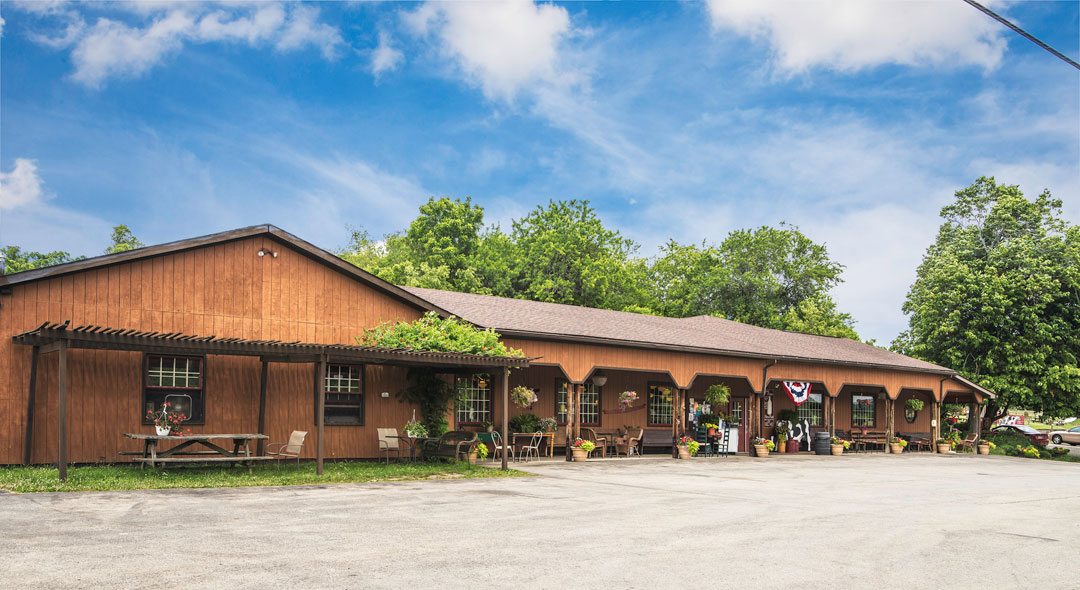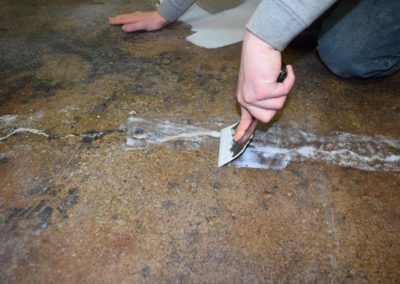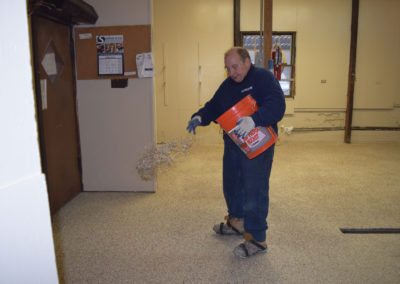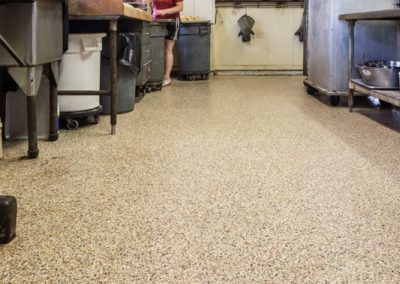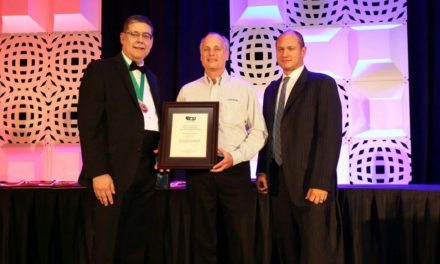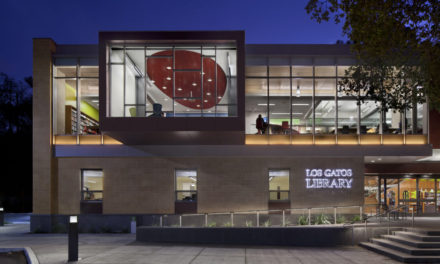The bakery featured commercial sheet vinyl flooring that was applied directly to the concrete slab-on-grade-substrate. The sheet vinyl failed in spots due to the infiltration of water and cleaning agents at the seams during the cleaning process. This disbonding created an area that could hold contaminants. As the seams started the fail, the problem was exacerbated by the trapped water, cleaning agents and contaminants, causing adhesion issues. This lead to replacing the damaged seams in the flooring by cutting out the section adjacent to the vinyl and installing a new piece of vinyl. After several repairs, the floor had a patchwork look and additional seams that could disbond. The owner decided to renovate the bakery, which included new wall coatings and a new floor option.
The owner reached out to a professional flooring contractor, Seaman Flooring, to discuss options that would be attractive, seamless and durable. The contractor faced a challenge of completing the whole renovation process in a two-and-a-half-day timeframe as the baked goods were a significant revenue stream for the business.
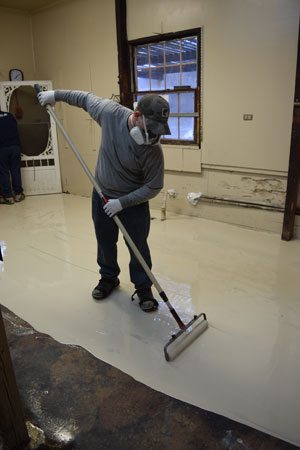
A beige pigmented ultra-low VOC polyaspartic basecoat was applied to the bakery floor at 15 mils thickness. Courtesy of Covestro LLC.
After inspecting the area and taking samples, the flooring contractor recommended removing the existing sheet vinyl and replacing it with a multiple-layer, high-performance floor coating system. The flooring contractor determined a resinous floor coating system with a topcoat of polyaspartic coating technology would address the needs of long-term durability, abrasion resistance, seamless design, aesthetics and fast return to service. The polyaspartic system was supplied by a private manufacturer and utilized Covestro raw materials in the formulation.
There are a variety of reasons for choosing a polyaspartic based floor coating. Polyaspartic coatings have long protected high-performance industrial applications such as, bridge, water and wastewater infrastructure. As a result of their proven performance, polyaspartic coatings have migrated into commercial and decorative flooring. With durable formulations that feature high solids, low viscosity resins that reduce the need for solvents, polyaspartic technology is also useful in meeting environmental regulations and LEED standards. Additionally, current commercial systems provide fast return-to-service, higher film build, lower volatile organic compound (VOC) content and odor, ease of use, and long-term aesthetics. Polyaspartic coating technology is also known for excellent UV, chemical and abrasion resistance; ultra-low VOCs; color stability; and, cleanability.
To ensure successful application of the new polyaspartic flooring system at SpringHouse Country Market, surface preparation was key. First, the flooring contractor removed the remaining sheet vinyl and adhesive. The floor was then cleaned thoroughly with a professional degreaser to remove the contamination that had affected the porous concrete surface. Following cleaning, the floor was prepared with a planetary grinder with 1820 grit diamonds. This resulted in a final surface with a profile of ICRI CSP 3 and the removal of any small amounts of residual adhesive. By cleaning before the grinding process, the contaminants were not ground into the substrate, which could possibly have affected long-term adhesion of the coating system. The inspection revealed some small cracks that the contractor repaired by chasing them with a fast curing epoxy mortar that was sanded similar to the concrete.
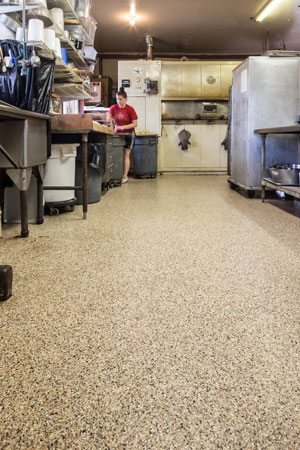
The end result is a seamless floor with a visually appealing finish that can handle the daily demands of a commercial bakery. Courtesy of Covestro LLC
With surface preparation complete, the next steps involved application of the floor coating system. Due to the slab-on-grade foundation, a clear epoxy was first applied as a vapor mitigation layer at 12 to 15 wet mils. It was applied using a squeegee then back rolled. This layer was allowed to cure overnight.
Next, a beige pigmented ultra-low VOC polyaspartic basecoat was applied at 15 mils thickness. Color chips in a five-color blend were broadcast into the wet basecoat to create a finished, high-end look. Once the basecoat cured sufficiently, about 90 minutes due to the fast return-to-service properties, the excess color chips were vacuumed up.
After the base coat cured further for approximately two hours, two thin layers of a clear polyaspartic topcoat were applied at 6-8 mills thickness using a 3/8” nap roller. Polyaspartic coatings are water clear, which results in an eye-catching color pop over color chip or decorative stained floor systems. The thin coats ensured the roughness of the color chips were not lost as the texture adds non-slip characteristics to the floor surface.
The finished floor was put back into service the morning after completion, meeting the required two-and-a-half-day timeframe. The end result is a seamless floor with a visually appealing finish that can handle the daily demands of a commercial bakery. The new floor provides slip resistance and is comfortable underfoot for employees. Compared to other floor coating systems, polyaspartic coatings provide a fast return-to-service which allowed the bakery to reopen quickly. The floor can withstand heavy equipment, wheeled traffic and frequent cleaning without significant wear and tear. It offers a great balance of abrasion, chemical, and scratch resistance while providing excellent long-term color and gloss retention, proving that a polyaspartic coating is the icing on the cake!
The flooring contractor repaired cracks by chasing them with a fast curing epoxy mortar. Courtesy of Covestro LLC.
The flooring contractor repaired cracks by chasing them with a fast curing epoxy mortar. Courtesy of Covestro LLC.
A beige pigmented ultra-low VOC polyaspartic basecoat was applied to the bakery floor at 15 mils thickness. Courtesy of Covestro LLC.
A beige pigmented ultra-low VOC polyaspartic basecoat was applied to the bakery floor at 15 mils thickness. Courtesy of Covestro LLC.
Color chips in a five-color blend were broadcast into the wet basecoat to create a finished, high-end look. Courtesy of Covestro LLC.
Color chips in a five-color blend were broadcast into the wet basecoat to create a finished, high-end look. Courtesy of Covestro LLC.
The end result is a seamless floor with a visually appealing finish that can handle the daily demands of a commercial bakery. Courtesy of Covestro LLC.
The end result is a seamless floor with a visually appealing finish that can handle the daily demands of a commercial bakery. Courtesy of Covestro LLC.
Steven Reinstadtler is the Construction Market Manager for coatings, adhesives, and sealants – CAS Business Unit of Covestro LLC in Pittsburgh. Steven works closely with contractors, companies and organizations that build infrastructure with durability and sustainability in mind by educating the market on high-performance coatings and sealant options.
He has been with Covestro for over 28 years in technical and marketing management positions. Steven holds a degree in chemistry with a polymer science option from the University of Pittsburgh and is an active member of professional societies such as AIA, CSI, ACS, SSPC, CPI, ACA, ESWP and PDA.

